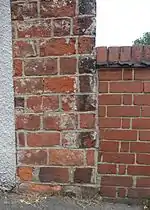Brick tax
The brick tax was a property tax introduced in Great Britain in 1784, during the reign of King George III, to help pay for the wars in the American Colonies. Bricks were initially taxed at 2s 6d per thousand.[1] To mitigate the effects of the tax, manufacturers began to increase the size of their bricks. Many buildings built by Joseph Wilkes in Measham, Leicestershire, used bricks known as Wilkes' gobs that were 9 1⁄4 in × 4 1⁄4 in × 4 1⁄4 in (230 mm × 110 mm × 110 mm).[2]
| Taxation in the United Kingdom |
|---|
.svg.png.webp) |
| UK Government Departments |
| UK Government |
|
| Scottish Government |
| Welsh Government |
| Local Government |
|

In 1801, the government responded by limiting the dimensions of a brick to 10 in × 5 in × 3 in (254 mm × 127 mm × 76 mm) and doubling the tax on bricks that were larger. The level of taxation was raised regularly, until its peak of 5s 10d per thousand bricks in 1805.[3] The brick tax was abolished in 1850,[4] by which time it was considered to be a detriment to industrial development.[5]
One of the consequences of the brick tax was that some minor brick producers went out of business, forced to sell their stock to meet tax arrears.[6] It also had an effect on architecture, with many areas returning to the use of timber and weatherboarding in house construction, especially weather tiles to simulate brick work, known as mathematical tiles.[7][8][9]
References
- "Brick Tax 1784 – 1850". 2015-06-20. Retrieved 2019-02-13.
- J.M. McComish (2015). "A Guide To Ceramic Building Materials" (PDF). p. 43. Retrieved 2019-02-13.
- Lucas, Robin (1997). "The Tax on Bricks and Tiles, 1784-1850: its Application to the Country at large and, in particular, to,the County of Norfolk" (PDF). Construction History Vol. 13. The Construction History Society. pp. 29–30.
- Murden, Sarah (2015-03-10). "18th Century Taxes". All Things Georgian. Retrieved 2020-03-05.
- Warren (1998), p. 53
- Chartered Institute of Building (1994), p. 49
- Brunskill & Clifton-Taylor (1977), p. 40
- Stenhouse (1977), p. 47
- "A History of Building Materials. By Norman Davey. (London: Phoenix House, J. M. Dent & Sons, 1961. Second impression, 1965. Distributed by Lawrence Verry, Inc., Mystic, Connecticut. Illustrations, bibliography, index. 260 pp. $14.00)". Forest & Conservation History. 10 (2): 22. July 1966. doi:10.2307/3982831. ISSN 1046-7009. JSTOR 3982831.
Further reading
- Davey, Norman (1961), A History of Building Materials, London: Phoenix House, p. 83
- Warren, John (1998), Conservation of Brick, Architectural Press, ISBN 978-0-7506-3091-7
- Journal of the Construction History Society, Volumes 10-15, Chartered Institute of Building, 1994
- Brunskill, R. W.; Clifton-Taylor, Alec (1977), English Brickwork, Ward Lock, ISBN 978-0-7063-5087-6
- Stenhouse, David (1977), Understanding Towns, Wayland, ISBN 978-0-85340-440-8
